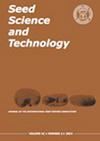萝卜种子活力常数与发芽率下降:一个结合活力方程和种群阈值模型分析
IF 3
4区 农林科学
Q2 AGRONOMY
引用次数: 0
摘要
除了叶子和根,萝卜苗被当作“微绿”食用。生产微型蔬菜需要高活力、高活力的种子。因此,了解储存过程中活力丧失和活力下降的速率不仅对萝卜发芽生产有用,而且对种子基因库中萝卜种质资源的保存也有帮助。萝卜' Kaiware '的种子是一种微绿色品种,在50°C下密封储存在6%到13%之间的7种湿度水平。每天对种子活力(从储存中取出后的萌发)进行评分,以确定萌发过程曲线。采用一步法拟合描述种子发芽率随衰老而下降的种群阈值(PBT)模型,并根据活力方程估计MC对寿命的影响。KE和CW分别为6.54和3.22。PBT模型的老化时间常数θage随贮藏含水量的增加而增加,反映了高MC下活力下降更快。通过预测不同品种“桑果紫”种子在45°C和8.61% MC下的活力损失,验证了该模型的有效性。本文章由计算机程序翻译,如有差异,请以英文原文为准。
Seed viability constants and the decline in germination rates for radish: a combined viability equation and population-based threshold model analysis
Aside from the leaves and roots, radish seedlings are consumed as a “microgreen”. Production of microgreens requires high viability, high vigour seeds. Knowledge of the rates of loss of viability and vigour decline during storage would therefore be useful for radish sprout production, but also in relation to the conservation of radish germplasm in seed genebanks. Seeds of radish ‘Kaiware’, a microgreen cultivar, were stored hermetically at seven moisture levels between 6% and 13% at 50°C. Seed viability (germination after removal from storage) was scored daily to determine germination progress curves. One-step analysis was used to simultaneously fit the population-based threshold (PBT) model describing the decline in germination rates with ageing and to estimate the effects of MC on longevity according to the viability equation. KE and CW were estimated as 6.54 and 3.22, respectively. The ageing-time constant for the PBT model, θage, increased as a function of storage moisture content, reflecting the faster decline in vigour at higher MC. The validity of the viability constants was tested by predicting viability loss in seeds of a different radish cultivar, ‘Sango Purple’, stored at 45°C and 8.61% MC.
求助全文
通过发布文献求助,成功后即可免费获取论文全文。
去求助
来源期刊

Seed Science and Technology
农林科学-农艺学
CiteScore
3.00
自引率
28.60%
发文量
36
审稿时长
>36 weeks
期刊介绍:
Seed Science and Technology (SST) is an international journal featuring original papers and articles on seed quality and physiology related to seed production, harvest, processing, sampling, storage, genetic conservation, habitat regeneration, distribution and testing. A journal that meets the needs of researchers, advisers and all those involved in the improvement and technical control of seed quality. Published every April, August and December.
 求助内容:
求助内容: 应助结果提醒方式:
应助结果提醒方式:


